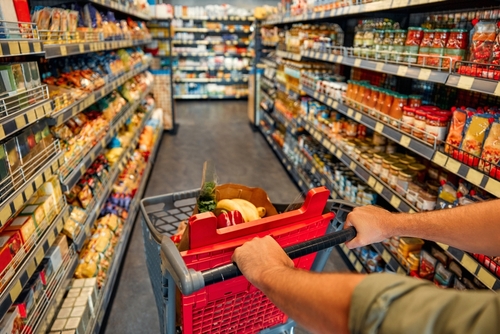Walking into a large American supermarket for the first time can feel overwhelming. The aisles seem endless, the brands are unfamiliar, the prices are different, and the comforting foods that remind you of home are nowhere in sight. This everyday task can suddenly feel like a major challenge, leaving you feeling disconnected and frustrated. How do you feed your family affordably while also holding on to the culinary traditions you love?
You’re not alone. At Remitly, we understand that food is about so much more than just sustenance—it’s about comfort, culture, and connection. That’s why we’ve created this guide filled with practical international grocery shopping hacks specifically for immigrants living in the US. We’ll walk you through how to navigate American grocery stores, save money, and successfully find those familiar foods that make a new place feel like home.
Why grocery shopping in a new country can be a challenge
Before we dive into the hacks, let’s acknowledge why grocery shopping abroad can feel so overwhelming. For many immigrants, something as routine as buying food suddenly comes with new hurdles. The good news is, you’re not alone. Millions of others have faced the same challenges and found ways to adapt.
Navigating unfamiliar stores and labels
From the layout of the store to the language on the packaging, everything feels different at first. Trying to decipher nutrition labels, ingredient lists, and marketing claims in English can be confusing and time-consuming.
Even something as simple as buying milk can be complicated, with countless options like whole, 2%, skim, organic, lactose-free, and dozens of plant-based alternatives.
Dealing with different prices
The cost of food in the US can be surprising, especially for fresh produce, meat, and international products. Without a local price reference, it’s hard to know if you’re really getting a good deal. To add to the confusion, sales tax is not included on the shelf price and is added at checkout, which can be an unwelcome surprise for newcomers.
The search for a taste of home
Perhaps the hardest part is finding the specific ingredients that are central to your culture’s cuisine. Whether it’s a particular type of chili pepper, a specific brand of fish sauce, or the right kind of cheese, the absence of these familiar flavors can make you feel even further from home. But the good news is, there are ways to find them.

7 smart grocery shopping hacks for immigrants in the US
These expat grocery shopping tips will help you shop with confidence, save money, and keep your kitchen stocked with the foods you love.
Hack #1: Understand the US grocery store landscape
Not all grocery stores are the same. The US has a tiered system, and knowing where to shop for what can save you money.
- Premium stores (e.g., Whole Foods, The Fresh Market): These stores are known for their high-quality organic produce and specialty items. They’re also the most expensive and are good for occasional splurges, not your everyday shopping.
- Mainstream stores (e.g., Kroger, Safeway, Albertsons, Publix): Standard supermarkets that most Americans use. They offer a wide variety of products and have weekly sales. With a bit of strategy, you can find good deals at these stores.
- Budget-friendly stores (e.g., Aldi, Food 4 Less, WinCo Foods): These no-frills stores offer significantly lower prices on staple items like pasta, canned goods, produce, and dairy. You may need to bring your own bags, but the savings are often worth it.
- Warehouse clubs (e.g., Costco, Sam’s Club): These stores require a membership but are excellent for buying items in bulk. This is a great option for families or for stocking up on staples like rice, oil, and other non-perishables.
Hack #2: Explore ethnic and specialty stores
One of the top ways to find familiar foods abroad is by visiting ethnic supermarkets. The US is incredibly diverse, and most cities have shops that cater specifically to immigrant communities.
How to find them: Use Google Maps and search for specific terms like “Indian groceries near me,” “Asian supermarket,” “Halal butcher,” “Mexican mercado,” or “Caribbean market.”
What you’ll find:
- An H-Mart or 99 Ranch Market will have a vast selection of Asian vegetables, sauces, and snacks.
- Patel Brothers will be your go-to for Indian spices, lentils, and fresh paneer.
- Local mercados will have the specific chili peppers and cheeses needed for authentic Latin American dishes.
Prices for these specialty items are often much cheaper here than in the international aisle of a mainstream supermarket.
Hack #3: Embrace local and seasonal produce
Buying out-of-season produce is one of the quickest ways to overspend. In the US, seasonal fruits and vegetables are much more affordable. For example, a pint of strawberries might be $7 USD in winter but only $2.50 USD in summer.
Look for what’s plentiful and on sale in the produce section, as this is also a wonderful way to explore new ingredients. You may even discover a local vegetable that works as a great substitute in one of your traditional dishes. For the freshest and often most affordable options, visit your local farmers’ market.

Hack #4: Master the American “sales culture”
To save money shopping abroad, it helps to learn the local sales system. The US system is built around weekly sales, coupons, and loyalty programs.
- Get the loyalty card: Many sale prices are only available to cardholders, so check if your local supermarket offers a loyalty card, as you can often sign up for free.
- Check the weekly advert: Before you shop, check the store’s weekly ad (or “flyer”) online or through their app. Plan your meals for the week around what’s on sale.
- Use digital coupons: Most store apps allow you to “clip” digital coupons directly to your loyalty card. Simply scroll through the offers and tap to add them before you shop. The discount will be applied automatically when you scan your card at checkout.
Hack #5: Navigate the “international aisle” strategically
Most big supermarkets have an international aisle that stocks a small selection of imported goods. While it’s exciting to see a familiar brand, these items are often priced at a significant markup.
Use this aisle for an occasional treat or an ingredient you desperately need and can’t find elsewhere. For your staple international ingredients, the ethnic grocery stores mentioned in Hack #2 will offer a much better price and selection.
Hack #6: Learn to make your own staples
If a specific spice blend, sauce, or type of bread from your home country is expensive or impossible to find, consider learning to make it from scratch. It’s often cheaper, healthier, and can taste even more authentic.
For example, instead of buying a tiny, expensive jar of garam masala, you can buy the individual whole spices (cumin, coriander, cardamom, etc.) and make a large batch for a fraction of the cost. The same goes for things like simple flatbreads, fresh cheese, or certain sauces.
Hack #7: Use online communities and apps
You don’t have to figure this all out on your own. You can:
- Join expat Facebook groups: Search on Facebook for groups like “[Your Nationality] in [Your City/State]” (e.g., “Brazilians in New Jersey”). These groups are an incredible resource. Members are constantly sharing tips on where to find ingredients, which stores have sales, and even recipes for making substitutes.
- Use price comparison apps: Apps like Flipp let you browse all the weekly ads across grocery stores in your area, making it easy to see who has the best deal on basics like chicken or tomatoes.

From confusing aisles to confident shopping
Navigating American grocery aisles doesn’t have to be a puzzling or expensive experience. It’s a skill that you will develop over time. With a mix of research, resourcefulness, and a willingness to experiment, you can save money, enjoy new flavors, and keep the comforting tastes of your home culture alive in your kitchen. Every trip to the store is an opportunity to learn and become more confident.
How Can Immigrants in the US Find Familiar Foods While Exploring Historical Sites Like Hammond Castle?
Immigrants in the US seeking familiar foods while exploring historical sites can find delightful options nearby. As they wander through areas surrounding attractions, like when they explore the charm of hammond castle, local markets and ethnic eateries often provide a taste of home, blending history with cultural flavors.
FAQs
How do I find international grocery stores near me in the US?
Use Google Maps or Yelp and be specific with your search terms. Try “Indian grocery,” “Asian supermarket,” “Halal meat,” “Latin market,” or “Russian food store.” Also, don’t hesitate to ask other immigrants or expats. Word of mouth is often the quickest way to discover hidden gems.
How can I save money if I don’t have a car to drive to different stores?
This can be tricky, but there are workarounds. Focus on a budget-friendly store that is accessible via public transportation for your main groceries. For specialty items, consider doing a larger “stock-up” trip once a month with a friend who has a car, or using a ride-sharing service, as the savings from buying in bulk at an ethnic or warehouse store can often offset the transportation cost.
How can I understand food labels and nutritional information?
Use a translation app on your phone, like Google Translate, which has a camera feature that can translate text in real-time. For nutritional information, familiarize yourself with key terms like “Serving Size,” “Calories,” “Fat,” “Sodium,” and “Sugar.”
Is it cheaper to shop online for familiar foods?
Sometimes. Websites like Amazon, iHerb, or specialty online grocers can be great for non-perishable items. But try to compare the final price, including shipping fees, to what you would pay at a local ethnic grocery store. Sometimes the convenience is worth it, but other times a local store is still the cheaper option.
